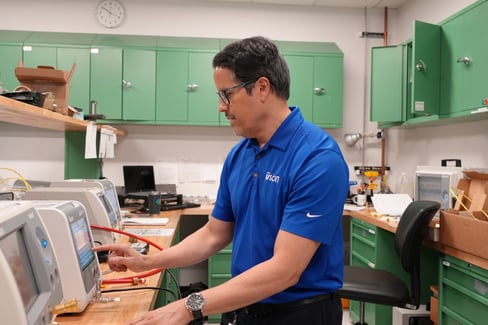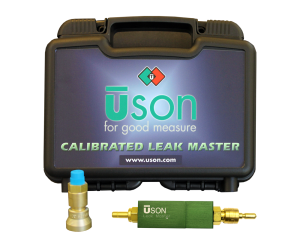In high-throughput manufacturing environments, leak testers are indispensable tools for product quality and regulatory compliance. However, even the most accurate instruments can experience calibration drift or fall out of tolerance (OOT) over time, especially in demanding production settings.
When a leak tester fails calibration, it raises immediate concerns about measurement accuracy, testing reliability, and product quality. The good news? With the right strategy in place, OOT conditions can be anticipated, identified early, and managed effectively.
Understanding the Challenge: What Causes OOT Conditions?
Out-of-tolerance results typically emerge during periodic calibration checks and can stem from a range of internal or external factors. These may include:
- Inconsistent calibration methods across service providers
- Environmental influences such as air quality or chemical exposure
- Part contaminates introduced back into the leak tester is another condition that can cause OOT failure. Do note that to prevent tester contamination, add an external filter in the test line or external vent valve.
- Gradual sensor drift due to operational wear
When testers fall out of tolerance, it's essential to isolate the root cause and determine whether the issue affects functional performance or simply the instrument’s reference baseline.

Engineering Insights: Root Causes and Proactive Prevention
Preventing OOT conditions isn’t about over-correcting, it's about smart, preventative system management. Based on technical evaluations, the most effective mitigation measures focus on three main areas:
- Air Supply Quality
Moisture and particulates in the compressed air line can degrade internal sensors over time. Additionally, exposure to harsh chemicals or vapors (such as acids or oxidizers) may compromise sensitive components.
Recommendation: Ensure a dry, filtered (<5 micron) air source at all times. Protect testers from corrosive fumes to prolong sensor life and reduce calibration drift.
- Calibration Interval Management
If a leak tester exhibits signs of drift, shortening the calibration interval is a practical first step. This not only minimizes the window of exposure but also builds trend data that can help diagnose recurring issues.
Recommendation: Reduce calibration intervals temporarily to monitor for repeat behavior. Doing so can help pinpoint whether drift is equipment-based or caused by external factors.
- Leak Master Validation
Leak testers operate by measuring the differential between two pressures (ΔP = P1 – P2). A Leak Master—a device with a known, controlled leak—offers a simple yet powerful way to verify tester accuracy without requiring full recalibration.
Recommendation: Use a Uson Leak Master for periodic or random checks between calibration cycles. This provides real-time assurance that Pass/Fail decisions remain valid.

The Role of Pressure Offset in Measurement Confidence
An important concept in leak testing is that a tester can still make valid decisions, even with a reported pressure offset.
If both the starting pressure (P1) and final pressure (P2) are affected equally by an offset (P’), the differential remains unchanged:
ΔP = (P1 + P’) – (P2 + P’) = P1 – P2
This means that while the absolute pressure reading may be slightly off, the leak detection outcome is still correct. In most cases, this has a negligible impact on product testing or process integrity.
It’s still important to investigate and resolve any OOT finding, but this concept offers reassurance that detection logic remains reliable in many real-world cases.
Practical Steps to Strengthen Your Leak Test Program
To maintain long-term measurement integrity, several low-effort but high-impact strategies can be implemented:
- Upgrade or maintain air filtration systems to protect equipment
- Integrate Leak Master checks into regular preventative maintenance
- Use calibration data trends to make informed interval adjustments
- Educate operators and technicians on the importance of air quality and handling
Key Takeaway: Prevention Builds Confidence
The best defense against unexpected calibration issues is a strong verification strategy. Leak testers are precise, dynamic systems that benefit from attention between calibration cycles, not just during them.
Best Practices for Long-Term Accuracy:
- Ensure a clean, dry, stable air supply
- Establish a thoughtful calibration plan
- Validate performance using Leak Master devices
These steps help safeguard product quality, reduce downtime, and ensure consistent compliance, regardless of the size or complexity of your operation.
Need Expert Guidance?
 Uson technical experts are here to support your leak test verification strategy, from preventative maintenance plans to tool recommendations like Leak Masters.
Uson technical experts are here to support your leak test verification strategy, from preventative maintenance plans to tool recommendations like Leak Masters.
Contact Uson Technical Support or give us a call 📞: +1 281-671-2000 to learn more.